Today’s recipe is a Japanese interpretation of Korean Beef Soup with Rice. Just the right amount of chilli from gochujang (Korean red chilli paste), and kimchi make this rice soup slightly spicy and sour.
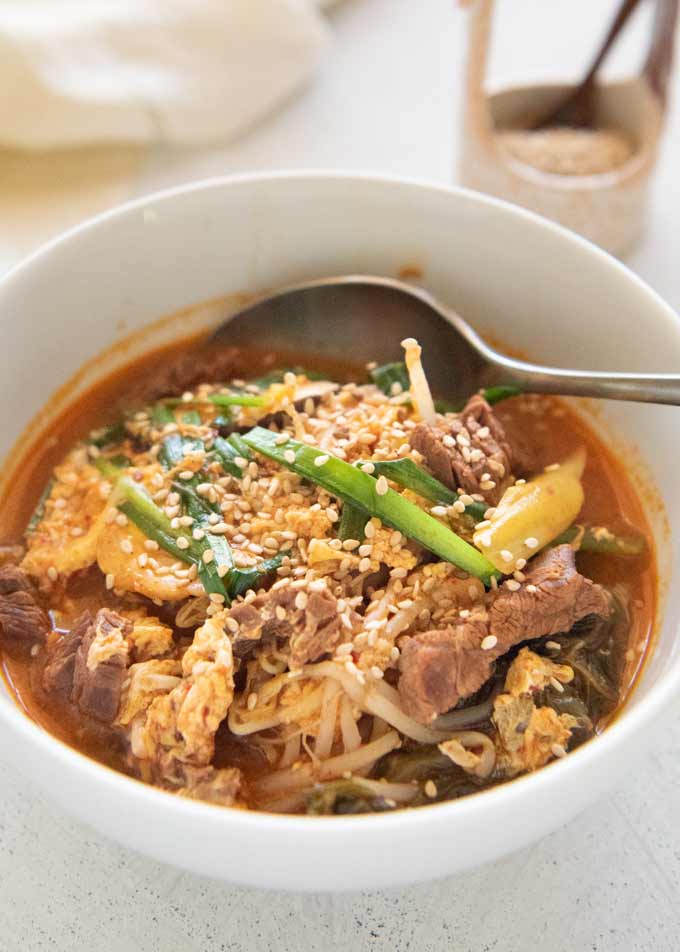
Gukbap is a Korean word for hot soup with rice (guk = soup, bap = rice). It is pronounced as /kuk̚p͈a̠p̚/ in International Phonetics Alphabets. That’s probably why it is called ‘kuppa’ (クッパ) in Japan.
Unlike my Zosui (Japanese Rice Soup – Ojiya), the rice is not cooked in the beef soup. The hot beef soup is poured over the cooked rice placed in a soup bowl.
This is the dish I used to finish with whenever I went to one of the Korean BBQ restaurants near Ueno station in Tokyo, where many Korean BBQ restaurants were open back in the 70’s. I also had just a bowl of gukbap for lunch on a cold day in winter. It’s so delicious.
My Korean Beef Soup uses much less chilli and garlic so the flavour is not too strong.
What’s in my Korean Beef Soup with Rice
The stock is made mainly from the sliced beef which is marinated in a spicy sauce before it’s sautéed and cooked.
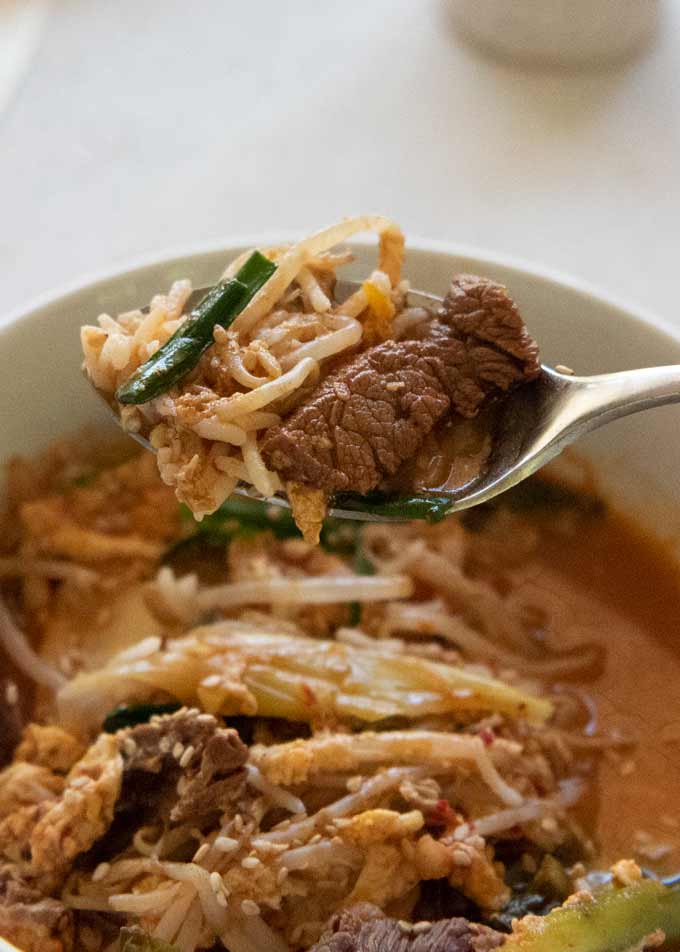
I can put ingredients into three major groups: Beef soup, Beef Marinade, and Vegetables, egg and rice.
Beef Soup
- Beef, cut into to 0.5-1 cm / 3⁄16-⅜” wide strips
- Minced garlic
- Sesame oil
- Water
- A sheet of konbu (kelp)
- Soy sauce
- Sugar
- A pinch of salt and pepper
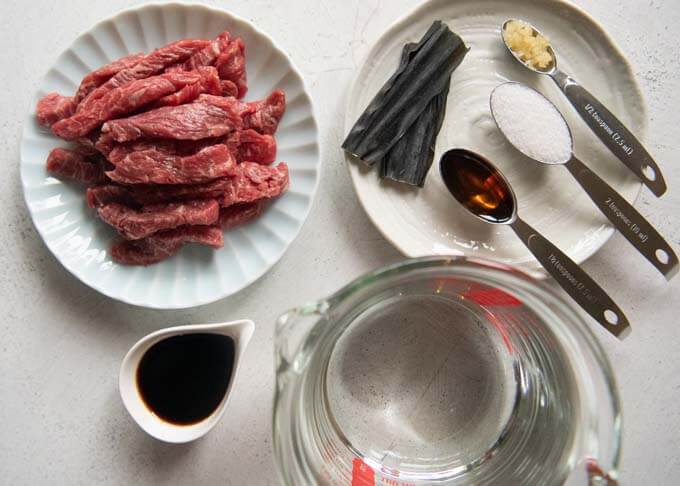
Since the beef is cooked only for 10 minutes or so, I would recommend using a tender cut of beef such as rib eye, sirloin or tenderloin. I happened to have left-over Wagyu flap steak sliced for Korean BBQ, so I used that. Flap steak is not usually recommended for simmering but Wagyu flap steak is very tender.
The addition of konbu gives this broth a Japanese touch. Instead of konbu, you can add a small amount of dashi powder or beef/chicken stock powder.
I understand that the broth of Korean Beef Soup is meant to be made from beef meat with bones. But I took a short cut so that the soup can be made fast.
Beef Marinade
Before sautéing, the beef strips are marinated in the Korean flavour.
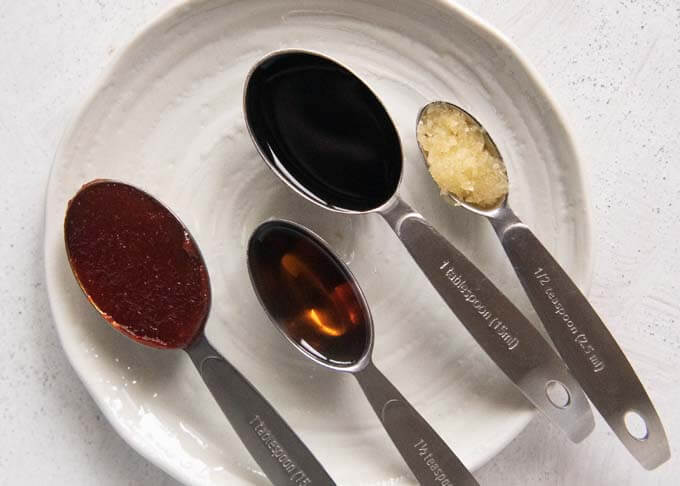
- ½ minced garlic
- 1 tbsp gochujang
- 1 tbsp soy sauce
- ½ tbsp sesame oil
Gochujang is a spicy fermented Korean condiment (red chilli paste). It is sold at Asian grocery stores or at some supermarkets. See the tub of Gochujang below.
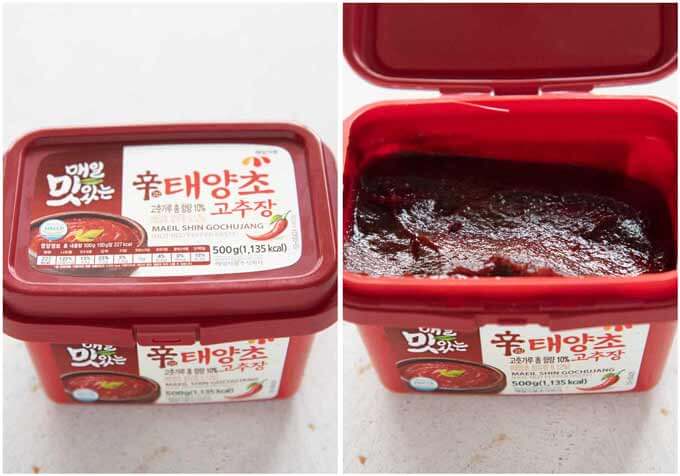
Vegetables, egg and Rice
- Kimchi – refer to my Simple Kimchi Recipe and make it yourself ahead of time, or buy a tub of kimchi (sold at most Asian grocery stores)
- Bean sprouts
- Shallots (Aussie)/scallions
- Garlic chives
- Beaten egg
- Cooked rice – must be hot or warm
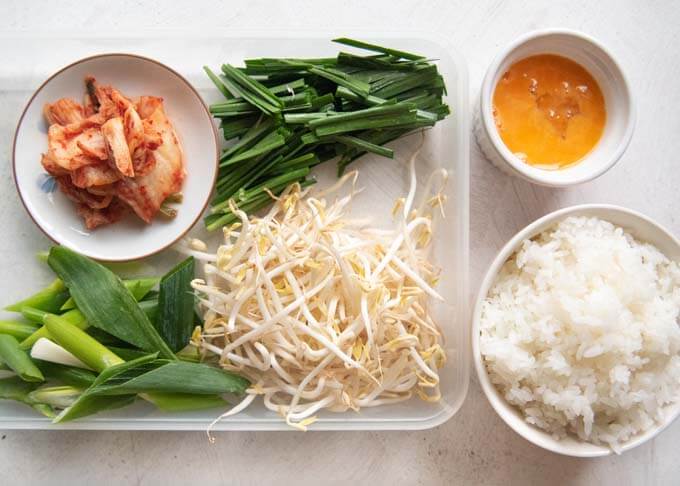
Garlic chives look like chives but the leaves are flat, with a flavour is more like garlic, not like chives. It gives a Korean touch to the dish and also a boost of the garlic flavour in the soup. But if you can’t find them, omit them and slightly increase the amount of minced garlic in the Beef Soup.
The vegetables listed above are the typical ingredients included in the soup when I used to eat out. But sliced carrots, shiitake mushrooms and Chinese/nappa cabbage can also go well with the soup.
How to make my Korean Beef Soup with Rice
Once you get the ingredients ready, the steps to make Korean Beef Soup with Rice are simple and it does not take very long.

- Marinate beef strips – 10 minutes.
- Sauté the beef strips.
- Add water and cook – 10 minutes.
- Add vegetables and flavouring, excluding garlic chives.
- Pour beaten egg with garlic chives.
- Place hot/warm cooked rice in a bowl, pour the soup over it.

The most efficient way of cooking is to get the beef and marinade ready, then get the other ingredients ready while the beef is marinating. This way, all the ingredients will be ready by the time the beef is marinated.
This is a great rice soup to eat in the cold of winter but I think you can have it any time other than very hot and humid summer weather. It is of course great without the rice, if you want to watch the calories! You can add more vegetables in place of rice.
Yumiko![]()
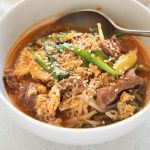
This is a Japanese interpretation of Korean Beef Soup with Rice. Just the right amount of chilli from gochujang (Korean red chilli paste) and Kimchi makes this rice soup slightly spicy and sour.
Prep Time includes time to marinate the beef strips as I assume that you prepare other ingredients while the beef is marinating.
Don't forget to see the section 'MEAL IDEAS' below the recipe card! It gives you a list of dishes that I have already posted and this recipe that can make up a complete meal. I hope it is of help to you.
- 50g / 1.8oz kimchi (note 2)
- 2 stalks shallots diagonally cut into 6cm / 2⅜” long pieces
- 70g / 2.5oz bean sprouts
- 30g / 1.1oz garlic chives cut into 6cm / 2⅜” long pieces
- 1 egg lightly beaten
- 230g / 8oz cooked rice (short, medium or long grain rice, 1½ Japanese serving bowls)
- ½ clove garlic minced
- 1 tbsp gochujang (Korean chili paste, note 3)
- 1 tbsp soy sauce
- ½ tbsp sesame oil
- Roasted white sesame seeds
-
Mix all the Marinade ingredients in a bowl. Add the beef strips to the marinade and massage well. Leave for minimum 10 minutes (note 4).
-
If kimchi vegetables are large, cut into bit size pieces.
-
Add sesame oil and garlic in a pot, cook until aroma of garlic comes out. Add the marinated beef, including the marinade and cook until the colour of the beef changes.
-
Add water and konbu and bring it to a boil. Reduce the heat to minimum and remove the konbu. Cook for 10 minutes. Remove scum occasionally as it comes up.
-
Add Kimchi, shallots and bean sprouts to the pot and cook for 30 seconds. Add soy sauce, sugar, salt and a pinch of pepper. Mix. Taste test and adjust with salt (note 5).
-
Add garlic chives, then spread the egg over the soup. When the egg is half cooked, turn off the heat, place a lid on to cook the egg with the residual heat of the soup.
-
Place cooked rice in serving bowls, pour the soup over the rice and sprinkle sesame seeds over.
1. Since you cook the beef only for 10 minutes or so, I would recommend using a tender cut of beef such as rib eye, sirloin and tenderloin.
2. Kimchi is a spicy Korean pickled vegetable, most commonly made with Chinese cabbage/nappa cabbage. You can buy kimchi at Asian grocery stores.
Use either store-bought kimchi or the home-made kimchi that I posted in Simple Kimchi Recipe.
3. Gochujang is a spicy fermented Korean condiment (red chilli paste). It is sold at Asian grocery stores or at some supermarkets.
You can substitute gochujang with sriracha (Thai chilli paste) or doubanjiang/toban-djan (hot Chinese bean paste).
4. I once left the beef marinating overnight because I ran out of time to cook it. It was 100% OK.
5. Depending on the brands, the amount of salt in the kimchi and gochujang may vary. Adjust the flavour to your taste. The flavour of the soup should be slightly strong as it will be poured over the rice.
6. The quantity of vegetables can vary as long as the total amount is similar to the recipe. You can also change/add vegetables, although the vegetables listed here are commonly used in the soup I had in Japan.
Other vegetables include sliced carrot, shiitake mushrooms and Chinese/nappa cabbage.
7. Nutrition per serving, assuming you drink all the soup.
serving: 759g calories: 587kcal fat: 27g (42%) saturated fat: 8.8g (44%) trans fat: 0.0g polyunsaturated fat: 4.3g monounsaturated fat: 11g cholesterol: 159mg (53%) sodium: 17393mg (75%) potassium: 760mg (22%) carbohydrates: 56g (19%) dietary fibre: 3.5g (14%) sugar: 15g protein: 30g vitamin a: 17% vitamin c: 31% calcium: 7.8% iron: 33%
Meal Ideas
A typical Japanese meal consists of a main dish, a couple of side dishes, a soup and rice. I try to come up with a combination of dishes with a variety of flavours, colours, textures and make-ahead dishes.
Since today’s dish is Korean-influenced, I attempted to come up with 4 small side dishes of different flavours and textures like banchan. Banchan is a collective name for the small side dishes served in Korean cuisine that you always get when you go to a Korean BBQ restaurant.
Gukbap is served as a main but it slightly lacks the amount of meat. So, I decided to include a small side dish with bonito. I used kimchi in the soup but I had to include home-made kimchi to make the meal a bit more authentic.
- Main: Korean Beef Soup with Rice (Gukbap) – today’s recipe
- Side dish 1: Bonito Kakuni (Simmered Bonito Cubes) – make ahead
- Side dish 2: Sesame Bean Sprouts – make ahead
- Salad: Konbu Seaweed Salad with Cucumber – or other dish using seaweed such as Hijiki Seaweed Salad
- Pickles: Simple Kimchi Recipe – make ahead
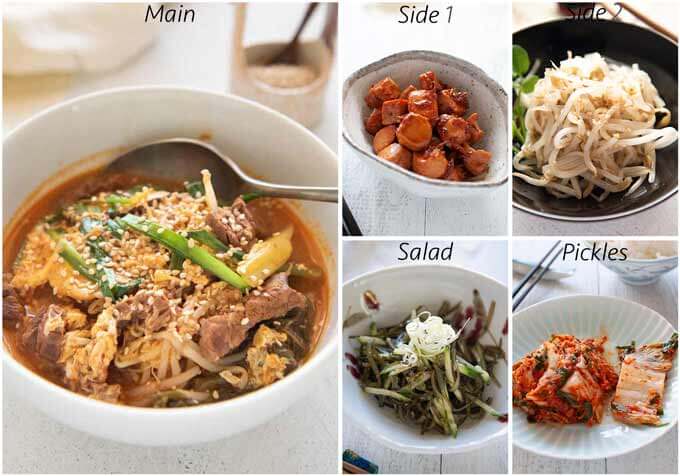
Awesome recipe!
Well written and easy to follow.
I didn’t have any Konbu, so I used a Bonito Dashi soup base instead.
Was really good, the spiciness was perfect for the family (they can’t handle too much spice).
Thanks again!
Hi Ross, that’s great! I assume you are from southern hemisphere. It is getting pretty cold and the soup dish like Korean Beef Soup with Rice is perfect for that.
Interesting recipe and I’m sure it’s tasty, but this is not authentic gukbap. 😉 The inclusion of gochujang, sugar, and kimchi are the biggest offenders imo. Gochujang and sugar are the flavor profiles of other popular Korean dishes like dak dori tang (spicy chicken soup), dak galbi (spicy grilled chicken), and jeyuk bokkeum (spicy stir-fried pork). Beef gukbap is spicy and red, sure, but it’s due to gochugaru (Korean red pepper flakes) instead of the somewhat sickly-sweet flavor profile of gochujang. It’s not supposed to be sweet compared to the other dishes mentioned above. And the inclusion of kimchi is just weird instead of sliced radish lol.
Hi Min, this is what I had when I was in Japan, sold as kuppa, which appeared to come from the name Gukbap. Definition of Gukbap in Japan is rice soup. I am sure it was heavily modified to suit to Japanese palate. Perhaps I should have said Korean-style. I added sugar but you don’t taste sweetness at all.
Loved this. Easy to make and tastes so good.
Geoff, it is easy and tasty, right? I get addicted.